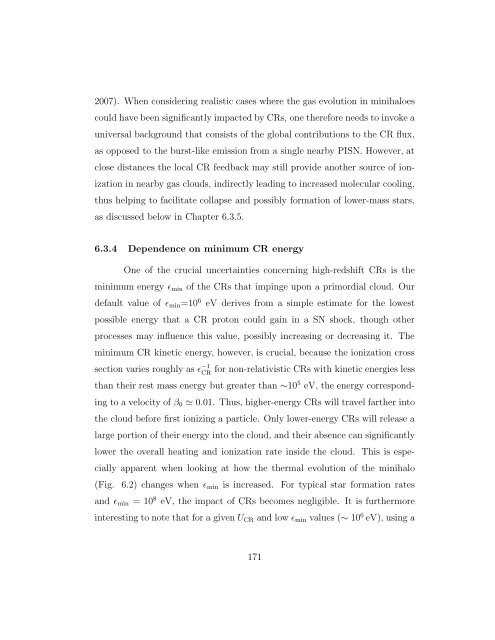Copyright by Athena Ranice Stacy 2011 - The University of Texas at ...
Copyright by Athena Ranice Stacy 2011 - The University of Texas at ...
Copyright by Athena Ranice Stacy 2011 - The University of Texas at ...
You also want an ePaper? Increase the reach of your titles
YUMPU automatically turns print PDFs into web optimized ePapers that Google loves.
2007). When considering realistic cases where the gas evolution in minihaloes<br />
could have been significantly impacted <strong>by</strong> CRs, one therefore needs to invoke a<br />
universal background th<strong>at</strong> consists <strong>of</strong> the global contributions to the CR flux,<br />
as opposed to the burst-like emission from a single near<strong>by</strong> PISN. However, <strong>at</strong><br />
close distances the local CR feedback may still provide another source <strong>of</strong> ion-<br />
iz<strong>at</strong>ion in near<strong>by</strong> gas clouds, indirectly leading to increased molecular cooling,<br />
thus helping to facilit<strong>at</strong>e collapse and possibly form<strong>at</strong>ion <strong>of</strong> lower-mass stars,<br />
as discussed below in Chapter 6.3.5.<br />
6.3.4 Dependence on minimum CR energy<br />
One <strong>of</strong> the crucial uncertainties concerning high-redshift CRs is the<br />
minimum energy ɛmin <strong>of</strong> the CRs th<strong>at</strong> impinge upon a primordial cloud. Our<br />
default value <strong>of</strong> ɛmin=10 6 eV derives from a simple estim<strong>at</strong>e for the lowest<br />
possible energy th<strong>at</strong> a CR proton could gain in a SN shock, though other<br />
processes may influence this value, possibly increasing or decreasing it. <strong>The</strong><br />
minimum CR kinetic energy, however, is crucial, because the ioniz<strong>at</strong>ion cross<br />
section varies roughly as ɛ −1<br />
CR for non-rel<strong>at</strong>ivistic CRs with kinetic energies less<br />
than their rest mass energy but gre<strong>at</strong>er than ∼10 5 eV, the energy correspond-<br />
ing to a velocity <strong>of</strong> β0 0.01. Thus, higher-energy CRs will travel farther into<br />
the cloud before first ionizing a particle. Only lower-energy CRs will release a<br />
large portion <strong>of</strong> their energy into the cloud, and their absence can significantly<br />
lower the overall he<strong>at</strong>ing and ioniz<strong>at</strong>ion r<strong>at</strong>e inside the cloud. This is espe-<br />
cially apparent when looking <strong>at</strong> how the thermal evolution <strong>of</strong> the minihalo<br />
(Fig. 6.2) changes when ɛmin is increased. For typical star form<strong>at</strong>ion r<strong>at</strong>es<br />
and ɛmin = 10 8 eV, the impact <strong>of</strong> CRs becomes negligible. It is furthermore<br />
interesting to note th<strong>at</strong> for a given UCR and low ɛmin values (∼ 10 6 eV), using a<br />
171









